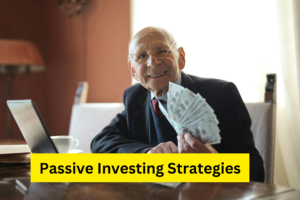Passive Investing Strategies: A Path to Long-Term Financial Success
In a world where the fast-paced, high-stakes stock market can leave us feeling overwhelmed, passive investing strategies offer a beacon of stability and peace of mind. For many, the idea of building wealth without constantly monitoring every market movement is not only appealing but essential. We understand the emotional tug of war between security and growth, and that’s where passive investing comes in. It’s more than just a strategy—it’s a lifestyle of long-term financial freedom.

What Is Passive Investing?
At its core, passive investing is about letting your money work for you. Unlike active investing, where individuals or fund managers buy and sell stocks frequently to beat the market, passive investing aims to mirror the market’s performance. This approach is designed to build wealth steadily over time by investing in a diversified portfolio of assets, such as index funds or ETFs (exchange-traded funds).
The beauty of passive investing lies in its simplicity. You don’t need to be glued to financial news or constantly making trades. Instead, passive investors believe in the long-term growth of the market, trusting that over time, it will yield positive returns. This strategy eliminates the stress of short-term market volatility and allows you to focus on the bigger picture.
also read: Safe Investment with High Risk: Balancing Returns and Security
The Emotional Appeal of Passive Investing
Passive investing is more than just a practical financial decision—it’s an emotional one too. Many of us are tired of the rollercoaster ride that active investing can bring. We long for consistency and the freedom to enjoy our lives without the anxiety of daily market fluctuations. Passive investing offers a sense of calm, allowing us to focus on other aspects of life while knowing our investments are growing steadily in the background.
By embracing a long-term perspective, passive investing removes the fear and uncertainty that come with trying to time the market. It’s about building financial security for the future, and that emotional peace is invaluable.
The Core Strategies of Passive Investing
1. Index Funds: The Cornerstone of Passive Investing
One of the most popular tools in passive investing is the index fund. These funds are designed to track the performance of a specific market index, such as the S&P 500. By investing in an index fund, you’re essentially buying a small piece of every company listed in that index. This means you’re diversifying your investment across a wide range of sectors and industries, reducing risk while still benefiting from the overall growth of the market.
Index funds are low-cost, as they don’t require active management. This makes them an attractive option for investors looking to minimize fees while maximizing long-term returns. The simplicity of index funds allows you to set it and forget it—one of the key pillars of successful passive investing.
2. Exchange-Traded Funds (ETFs): Flexibility Meets Simplicity
ETFs offer another powerful tool for passive investors. Like index funds, ETFs track the performance of a particular index, sector, or commodity. However, ETFs trade on exchanges, which means they can be bought and sold throughout the day, providing more flexibility.
For those who are looking for diversification without the need for constant monitoring, ETFs are an excellent choice. They often come with lower fees than mutual funds and offer exposure to a broad spectrum of assets, making them a cornerstone of many passive investing portfolios.
3. Dollar-Cost Averaging: Building Wealth Gradually
One of the most emotionally satisfying passive investing strategies is dollar-cost averaging. This involves investing a fixed amount of money into the market at regular intervals, regardless of market conditions. Whether the market is up or down, you continue to invest consistently.
This approach allows you to buy more shares when prices are low and fewer shares when prices are high, ultimately lowering the average cost of your investments over time. It takes the emotion out of investing and helps you avoid the temptation to time the market. Over the long term, this strategy has proven to be an effective way to build wealth.
4. Rebalancing Your Portfolio: Maintaining the Right Mix
Even with a passive approach, it’s important to periodically rebalance your portfolio to ensure it aligns with your long-term financial goals. As certain assets outperform others, your portfolio’s risk profile can change. Rebalancing involves selling some of the overperforming assets and buying more of the underperforming ones to maintain the desired asset allocation.
This step may seem counterintuitive—why sell what’s doing well? But rebalancing ensures that you’re not overexposed to one particular asset class, which could increase risk. It’s a simple yet effective way to stay on course with your passive investment strategy.
Why Passive Investing Works in the Long Run
The power of passive investing lies in its ability to harness the long-term growth of the market. While there may be short-term volatility, the overall trend of the stock market has historically been upward. By staying invested and resisting the urge to sell during market downturns, passive investors can benefit from compounding returns—the process of earning returns on both your initial investment and the returns themselves.
Compounding is a powerful force that grows exponentially over time, and it’s one of the key reasons passive investing can be so effective. The longer you stay invested, the more time your money has to grow. It’s not about chasing immediate profits—it’s about building sustainable wealth over decades.
The Emotional Discipline of Staying the Course
One of the greatest challenges in passive investing is the emotional discipline required to stay invested during market downturns. When the market drops, the instinct to sell in a panic can be overwhelming. But successful passive investors know that these downturns are a normal part of the market cycle.
By focusing on the long-term, passive investors can ride out short-term volatility with confidence. This emotional resilience is one of the most important factors in achieving success with a passive investment strategy. It’s about believing in the long-term growth of the market and trusting that your investments will recover and continue to grow over time.
Common Misconceptions About Passive Investing
1. Passive Investing Means No Risk
While passive investing is often seen as a safer approach than active investing, it’s important to recognize that it still carries risk. All investments involve some level of risk, and passive strategies are no exception. However, the diversification and long-term focus of passive investing help mitigate those risks.
2. Passive Investors Should Never Touch Their Portfolio
Some people believe that passive investing means you should never touch your portfolio once you’ve made your initial investments. While it’s true that passive investing requires less maintenance than active investing, periodic rebalancing is essential to ensure your portfolio remains aligned with your goals.
3. Passive Investing Is Only for Beginners
Passive investing is often associated with beginners, but it’s a strategy that can benefit investors of all levels. Many of the world’s wealthiest and most successful investors, including Warren Buffett, have advocated for passive investing as a smart long-term approach to building wealth.
Why Passive Investing Is the Future
In an era where the pace of life is faster than ever, passive investing offers a refreshing alternative to the constant hustle of active investing. By focusing on long-term growth, minimizing fees, and removing the emotional stress of daily market fluctuations, passive investing provides a pathway to financial freedom that fits seamlessly into modern life.
For those who want to grow their wealth while maintaining balance and peace of mind, passive investing strategies offer a solution that stands the test of time. It’s not just about making money—it’s about creating a life of abundance without sacrificing your well-being along the way.





